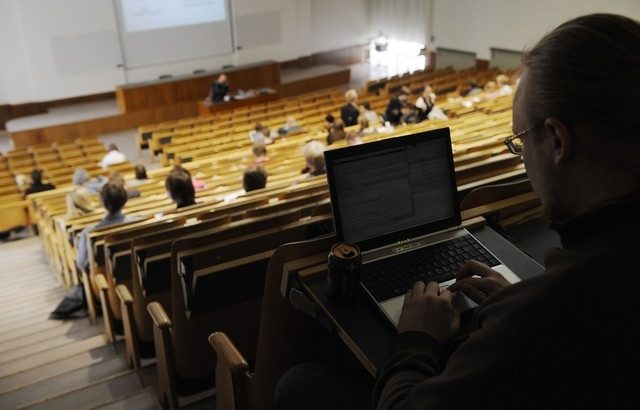Europa/Finlandia/Junio 2016/Autor: Peter Hatherley-Greene / Fuente: thenational.ae
Resumen: Las razones detrás del notable éxito del sistema educativo de Finlandia incluyen elevar el estatus de la profesión docente, la aplicación del financiamiento público integral e igualitario, y enseñar a los estudiantes para alentarlos a aprender, en lugar de utilizar pruebas de gran importancia para medir y comparar la eficacia de las escuelas. Finlandia es ahora considerado como una de las sociedades más culta del mundo, donde el 94 por ciento de los que inician la escuela secundaria superior pasa al universitario.
The reasons behind Finland’s remarkably successful education system include elevating the status of the teaching profession, applying comprehensive and egalitarian public funding, and teaching students to encourage them to learn, rather than using high-stakes tests to measure and compare schools’ effectiveness. Finland is now regarded as one of the world’s most literate societies where 94 per cent of those who start upper secondary school go on to graduate.
Many people exclaim: “Let’s simply do what the Finns have done and we’ll reap similar social, economic and educational benefits.»
It’s not going to happen, and I’ll tell you why. A society’s approach to education reflects its beliefs and values. Finland’s school system is a product of its unique culture. Just as the majlis system found in many Arab countries reflects traditional values, so too Finland’s educational system reflects its own societal values.Thus, the Finnish phenomenon is largely unexportable.
Finland provides three years of maternity leave and subsidised daycare to parents and preschool for all five-year-olds.
Finns are, by and large, practical people. In the 1970s, public schools were organised into one system with a national curriculum that provided guidelines not prescriptions.
In 1979, it was decided that every teacher earn a fifth-year master’s degree in theory and practice. As a result, schoolteachers achieved equal professional status with doctors and lawyers.
Finland truly believes that less is more. They are not an over-consuming people – they live simply.
This outlook is unique to Finland due to its geography, climate and history. All human societies have unconsciously embedded core assumptions about life that represent the outcome of their struggles for survival.
For example, in the harsh desert areas of the Middle East, Arab people have lived and survived for nearly 8,000 years. The early Arabs developed social protocols that enabled them to survive.
Finns also live in a difficult region and as a result, they have developed a strong sense of independence and self-reliance.
They are also prepared to make difficult decisions in the child’s interest.
In one example, a classroom teacher decided to hold back a student for a year. Many years later, the 20-year-old student showed up at his old teacher’s house. “You helped me,» he told his former teacher as the former student had gone on to open his own car repair firm. The teacher later told a visiting journalist: “This is what we do every day, prepare kids for life.»
Finnish egalitarianism is a practical response to a harsh and difficult climate where survival of the one ensured that many would also survive. Strongly individualistic, they nevertheless understand that social strength and community resilience occurs when everyone is treated the same and has similar opportunities to productively live their lives.
Research undertaken by Geert Hofstede, a Dutch national who compiled the world’s largest matched-sample, cross-national cultural database in the 1970s, identified significant differences in national cultures on four primary dimensions: power distance, individualism, uncertainty avoidance and masculinity.
In comparing Finland to the UAE in terms of “power distance», Finland appears to favour independence and egalitarianism, and employee consultation in decision-making.In contrast, Emiratis tend to accept a social hierarchy and deference to figures of authority.
The UAE is a collectivist society in that its members strongly associate themselves with the larger community, sometimes subsuming their personal wishes for the greater good of the group.
In contrast, Finland sometimes favours the individual’s wishes and desires above the family or wider community.
A masculine society is driven by competition, achievement and success. Finland is considered to be a feminine society where people value collaboration, equality and quality in their lives.
On the other hand, the UAE appears to be a more balanced society, giving equal importance to both masculine and feminine traits.
Finally, the extent to which the members of a culture feel threatened by unknown situations and have created beliefs systems to avoid these is reflected in the score on Uncertainty Avoidance.
The UAE scores 80 on this dimension and thus has a high preference for avoiding uncertainty.
Such societies respect rigid codes of belief and behaviour. Finland is more accepting of the whims and fancies of life, perhaps more tolerant of nonconformist ideas and behaviours.
In summary, there is much to be learned from the way Finland organises its society and important institutions but we all need to fully understand the complexity and uniqueness that lies at the heart of its success.
Fuente de la noticia: http://www.thenational.ae/opinion/comment/why-finnish-model-of-education-cannot-be-imported-to-the-uae
Fuente de la imagen: http://www.thenational.ae/storyimage/AB/20160516/OPINION/160519256/AR/0/&NCS_modified=20160516153741&MaxW=640&imageVersion=default&AR-160519256.jpg







 Realizar todo lo anterior, y hacerlo de manera profesionalmente responsable, requiere de una gran entrega, de un fuerte compromiso. El Servicio Profesional Docente ya lo reconoce. Ahora que existe una reglamentación clara para el ingreso, la promoción, el reconocimiento y la permanencia de los docentes en este trabajo profesional, el maestro puede tener dos certezas: que su desarrollo en la profesión docente depende enteramente de él, de su mérito y de su desempeño profesional, y que el Estado está obligado a hacerse cargo —y lo hará con mucha mayor fortaleza en el futuro próximo— de su formación permanente y del acompañamiento profesional para la mejora de su desempeño cotidiano. Los maestros mexicanos tienen ahora una perspectiva de carrera profesional claramente trazada.
Realizar todo lo anterior, y hacerlo de manera profesionalmente responsable, requiere de una gran entrega, de un fuerte compromiso. El Servicio Profesional Docente ya lo reconoce. Ahora que existe una reglamentación clara para el ingreso, la promoción, el reconocimiento y la permanencia de los docentes en este trabajo profesional, el maestro puede tener dos certezas: que su desarrollo en la profesión docente depende enteramente de él, de su mérito y de su desempeño profesional, y que el Estado está obligado a hacerse cargo —y lo hará con mucha mayor fortaleza en el futuro próximo— de su formación permanente y del acompañamiento profesional para la mejora de su desempeño cotidiano. Los maestros mexicanos tienen ahora una perspectiva de carrera profesional claramente trazada.






 Users Today : 103
Users Today : 103 Total Users : 35460009
Total Users : 35460009 Views Today : 149
Views Today : 149 Total views : 3418614
Total views : 3418614